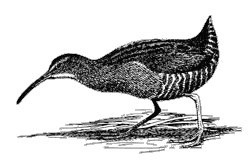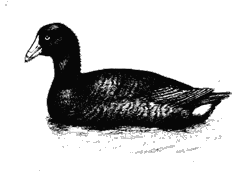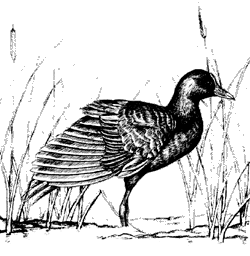Marsh Birds
Most members of the rail family are associated with water, but not all in the same ways. “Typical” rails inhabit dense marshes, and are seldom seen as they slip among the cattails and other aquatic plants. In contrast, coots are rail relatives that act like ducks, swimming and diving freely on open water. Moorhens and Gallinules behave like either ducks or rails, sometimes swimming in the open and sometimes fading into the marsh. All of these birds have distinctive voices, but the typical rails call mostly at night, in keeping with their secretive nature.
 |
Although they appear to be weak fliers, members of the rail family have established themselves all over the globe, even colonizing many oceanic islands. Therefore, it is hardly surprising that they manage to find the wetlands scattered through the Sonoran Desert. American Coots and Common Moorhens may appear on any marsh-edged ponds, and a couple of small species (Virginia Rail and Sora) are widespread as winter visitors. The most notable rail of the region is the Yuma Clapper Rail. This endangered subspecies is practically confined to the marshes of the lower Colorado River.
—Kenn KaufmanSonoran Desert species:
Yuma Clapper Rail (Rallus longirostris yumanensis)
American Coot (Fulica americana)
Common Moorhen (Gallinula chloropus)
Order: Gruiformes
Family: Rallidae
Spanish names: ralón (rail), gallareta (coot and moorhen)
Distinguishing Features
 |
Coots and moorhens are both the size and shape of chickens (but behave more like ducks); they also have chicken-like bills, white in the case of the adult coot, red in the moorhen. When swimming, they pump their heads back and forth as they go. Rails, which are rarely seen, are henlike in appearance, narrow-bodied for running through the marsh vegetation (“thin as a rail”), and cryptically colored.
Feeding
• Diet: Coots and moorhens eat aquatic plants and animals. Rails do as well, though they forage on land, or in shallow water, slipping about through dense marsh vegetation.
Habitat
 |
All these birds are found associated with freshwater cattail marshes of lakes, ponds, and rivers or coastal marshes. Coots are frequently found on open water; rails seldom are.
Life History
All members of the rail family can swim and dive, but Coots are as aquatic as ducks. They have lobes along their toes, which flare out on the back stroke to give them propulsion and which fold back on the forward stroke.
Moorhens, also called Gallinules, are equally at home in the water or on shore; long toes help them walk across the water on the tops of water plants. They are less gregarious and somewhat more secretive than coots.
The Yuma Clapper Rail is the only Clapper Rail that occurs in freshwater marshes in the United States. Its historic habitat was the marshes of the Colorado River delta in Mexico. Most of these marshes have dried up or been destroyed through channelization, and although the creation of marshes behind dams elsewhere in the Colorado river system has extended the rail’s range, it is still endangered. The only population of this subspecies in Mexico is found at the Ciénega de Santa Clara on the former flood plain of the lower Colorado River.










